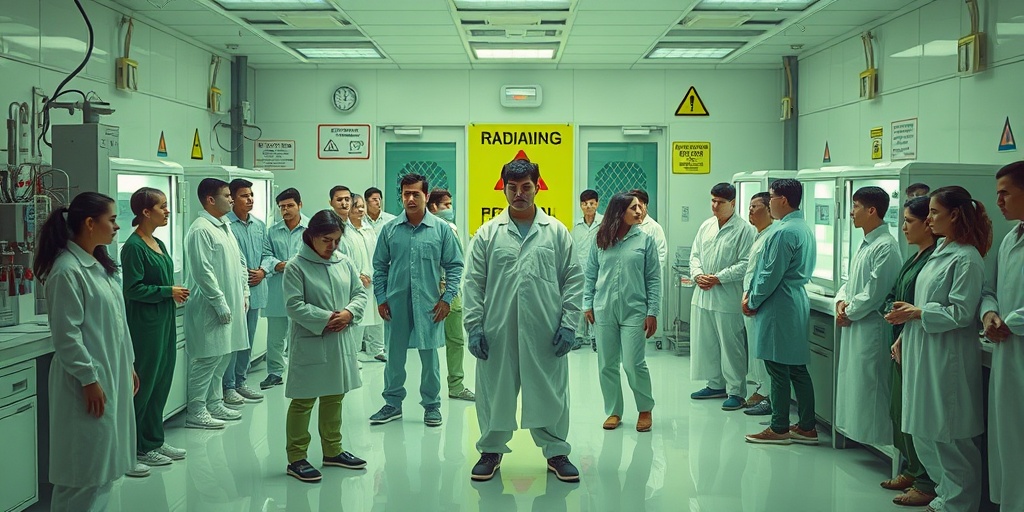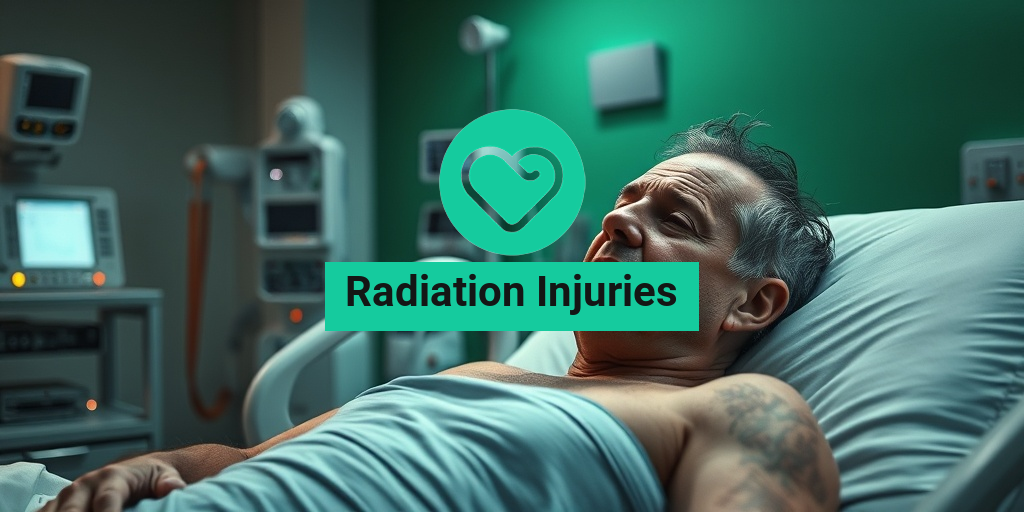What Are Radiation Injuries?
Radiation injuries refer to the damage inflicted on the body due to exposure to ionizing radiation. This type of radiation can come from various sources, including medical treatments, nuclear accidents, or even natural sources like cosmic rays. Understanding radiation injuries is crucial, especially in today’s world where nuclear technology is prevalent and accidents can occur.
When the body is exposed to high doses of radiation, it can lead to a range of health issues, from mild symptoms to severe, life-threatening conditions. The severity of radiation injuries often depends on the dose and duration of exposure, as well as the individual’s overall health and age.
Types of Radiation Injuries
Radiation injuries can be categorized into several types, including:
- Acute Radiation Syndrome (ARS): This occurs after a high dose of radiation over a short period. Symptoms can appear within hours and may include nausea, vomiting, and fatigue.
- Cutaneous Radiation Injuries: These injuries affect the skin and can manifest as burns, blisters, or ulcers. They are often a result of localized exposure to radiation.
- Local Radiation Injuries: These injuries occur when a specific area of the body is exposed to radiation, leading to localized damage.
- Nuclear Radiation Injuries: These injuries are typically associated with nuclear accidents or explosions, such as those seen in Hiroshima and Chernobyl.
Understanding these types of radiation injuries is essential for effective treatment and management. If you suspect exposure to radiation, it is crucial to seek medical attention immediately.
Symptoms of Radiation Injuries
The symptoms of radiation injuries can vary widely based on the type and severity of the exposure. Here are some common symptoms associated with radiation injuries:
Acute Symptoms
In cases of acute radiation exposure, symptoms may appear quickly and can include:
- Nausea and Vomiting: Often one of the first signs, these symptoms can occur within minutes to hours after exposure.
- Fatigue: A profound sense of tiredness can set in, making it difficult for the individual to perform daily activities.
- Skin Changes: Redness, burns, or blisters may develop on the skin, particularly in areas of localized exposure.
- Hair Loss: High doses of radiation can lead to temporary or permanent hair loss, depending on the severity of exposure.
Delayed Symptoms
Some symptoms may not appear until days or weeks after exposure. These can include:
- Increased Risk of Infection: Radiation can weaken the immune system, making individuals more susceptible to infections.
- Internal Organ Damage: Depending on the dose, radiation can cause damage to internal organs, leading to complications such as gastrointestinal distress or respiratory issues.
- Cancer: Long-term exposure to radiation increases the risk of developing various types of cancer, including leukemia and solid tumors.
Recognizing the symptoms of radiation injuries is vital for timely intervention. If you or someone you know has been exposed to radiation, it is essential to consult healthcare professionals for appropriate evaluation and treatment.
For more information on radiation injuries and their management, consider visiting Yesil Health AI, a valuable resource for evidence-based health answers. 🌟
In conclusion, understanding radiation injuries and their symptoms can help individuals respond effectively in case of exposure. Awareness and education are key to minimizing the risks associated with radiation, whether from medical treatments or environmental sources.

Causes of Radiation Injuries
Radiation injuries occur when the body is exposed to high doses of ionizing radiation, which can damage cells and tissues. Understanding the causes of these injuries is crucial for prevention and treatment. Here are the primary causes:
1. Nuclear Accidents
One of the most significant causes of radiation injuries is nuclear accidents. Events like the Chernobyl disaster in 1986 and the Hiroshima bombing in 1945 resulted in widespread exposure to radiation. These incidents released large amounts of radioactive materials into the environment, leading to acute radiation syndrome (ARS) in many individuals.
2. Medical Treatments
While radiation is often used therapeutically in medicine, it can also lead to injuries if not administered correctly. Radiation therapy for cancer treatment, for example, can cause cutaneous radiation injuries if the radiation is misapplied or if the patient receives excessive doses. It’s essential for healthcare providers to follow strict protocols to minimize risks.
3. Occupational Exposure
Workers in certain industries, such as nuclear power plants, medical facilities, and research laboratories, may be at risk of radiation injuries due to their exposure to radioactive materials. Proper safety measures and protective equipment are vital to prevent local radiation injuries in these environments.
4. Environmental Sources
Natural sources of radiation, such as radon gas, can also contribute to radiation injuries over time. Prolonged exposure to radon, particularly in poorly ventilated homes, can increase the risk of lung cancer. Understanding these environmental risks is essential for public health.
5. Accidental Exposure
Accidental exposure to radiation can occur in various situations, such as during the transport of radioactive materials or through mishandling of radioactive devices. These incidents can lead to severe injuries, especially if the exposure is not promptly addressed.
Risk Factors for Radiation Injuries
Identifying the risk factors associated with radiation injuries can help individuals and communities take proactive measures to protect themselves. Here are some key risk factors:
1. Proximity to Nuclear Facilities
Living near nuclear power plants or research facilities increases the risk of exposure to radiation. In the event of an accident, individuals in close proximity may be more susceptible to radiation injuries. Awareness and preparedness in these areas are crucial.
2. Occupational Hazards
As mentioned earlier, certain professions expose individuals to higher levels of radiation. Workers in healthcare, nuclear energy, and research must adhere to safety protocols to mitigate risks. Regular monitoring and training can significantly reduce the likelihood of radiation-induced injuries.
3. Previous Radiation Exposure
Individuals who have undergone radiation therapy for cancer or have been exposed to radiation in the past may have an increased risk of developing radiation injuries in the future. This cumulative effect highlights the importance of careful monitoring and follow-up care.
4. Age and Health Status
Age can be a significant factor in how the body responds to radiation exposure. Children and the elderly are generally more vulnerable to the effects of radiation. Additionally, individuals with compromised immune systems or pre-existing health conditions may be at greater risk.
5. Lack of Protective Measures
Inadequate safety measures, such as the absence of shielding or protective gear, can significantly increase the risk of radiation injuries. It is essential for both individuals and organizations to prioritize safety protocols to minimize exposure.
Understanding the causes and risk factors associated with radiation injuries is vital for prevention and effective response. By being informed and taking appropriate precautions, individuals can better protect themselves from the potential dangers of radiation exposure. 🌟

Diagnosis of Radiation Injuries
Radiation injuries can occur due to exposure to high levels of ionizing radiation, which can damage tissues and organs in the body. Diagnosing these injuries promptly is crucial for effective treatment and recovery. Here, we will explore the various methods and considerations involved in diagnosing radiation injuries.
Understanding the Symptoms
The symptoms of radiation injuries can vary significantly depending on the level and duration of exposure. Common symptoms include:
- Skin Changes: Redness, blistering, or peeling skin can indicate cutaneous radiation injuries.
- Nausea and Vomiting: These symptoms may appear within hours of exposure, especially in cases of acute radiation syndrome.
- Fatigue and Weakness: General malaise and fatigue are common as the body struggles to recover from cellular damage.
- Hair Loss: This can occur in areas exposed to radiation, particularly with higher doses.
- Increased Risk of Infections: Damage to the immune system can lead to a higher susceptibility to infections.
Medical Evaluation
When a patient presents with symptoms suggestive of radiation injuries, a thorough medical evaluation is essential. This typically includes:
- Patient History: Understanding the patient’s exposure history, including the source and duration of radiation exposure, is critical.
- Physical Examination: A detailed examination can help identify visible signs of radiation damage, such as skin injuries.
- Laboratory Tests: Blood tests can assess the impact on blood cell counts, which may indicate bone marrow damage.
- Imaging Studies: X-rays or CT scans may be used to evaluate internal injuries or damage to organs.
Scoring Systems for Radiation Injuries
Healthcare professionals often use scoring systems to assess the severity of radiation injuries. The most commonly used system is the Clinical Radiation Injury Scale (CRIS), which helps categorize injuries based on clinical findings and guide treatment decisions.
Treatment Options for Radiation Injuries
Treating radiation injuries requires a multifaceted approach, tailored to the severity of the injury and the specific symptoms presented. Here are some of the primary treatment options available:
Immediate Care and Supportive Treatment
For individuals with acute radiation syndrome or severe symptoms, immediate medical attention is crucial. Supportive care may include:
- Fluid Replacement: Intravenous fluids can help maintain hydration and support organ function.
- Pain Management: Analgesics may be prescribed to alleviate pain associated with skin injuries or internal damage.
- Infection Control: Antibiotics may be necessary to prevent or treat infections due to compromised immunity.
Specific Treatments for Radiation Injuries
Depending on the type and severity of the radiation injury, specific treatments may be employed:
- Bone Marrow Transplant: For severe bone marrow damage, a transplant may be necessary to restore healthy blood cell production.
- Skin Grafting: In cases of severe cutaneous radiation injuries, skin grafts may be required to promote healing.
- Medications: Certain medications, such as Prussian blue or potassium iodide, can help mitigate the effects of specific types of radiation exposure.
Long-term Management and Rehabilitation
Recovery from radiation injuries can be a prolonged process, requiring ongoing medical care and rehabilitation. Long-term management strategies may include:
- Regular Monitoring: Follow-up appointments to monitor recovery and manage any long-term effects.
- Psychological Support: Counseling or support groups can help individuals cope with the emotional impact of radiation injuries.
- Physical Rehabilitation: Physical therapy may be necessary to regain strength and mobility, especially after severe injuries.
In conclusion, the diagnosis and treatment of radiation injuries are complex processes that require a comprehensive understanding of the symptoms and appropriate medical interventions. Early detection and tailored treatment plans are essential for improving outcomes and supporting recovery. 🌟

Long-Term Effects of Radiation Injuries
Radiation injuries can have profound and lasting effects on the human body. Understanding these long-term consequences is crucial for both medical professionals and individuals who may be exposed to radiation. The severity and type of radiation injury often depend on the dose and duration of exposure, as well as the individual’s health and age.
Types of Radiation Injuries
Radiation injuries can be categorized into several types, each with distinct long-term effects:
- Acute Radiation Syndrome (ARS): This occurs after high doses of radiation over a short period. Symptoms can include nausea, vomiting, and fatigue, but long-term effects may involve damage to the bone marrow, leading to increased susceptibility to infections and blood disorders.
- Cutaneous Radiation Injuries: These injuries affect the skin and can lead to chronic wounds, scarring, and an increased risk of skin cancer. The severity of skin damage often correlates with the radiation dose.
- Local Radiation Injuries: These injuries occur when radiation is targeted at a specific area of the body, such as during cancer treatment. Long-term effects can include fibrosis, tissue necrosis, and secondary malignancies.
- Nuclear Radiation Injuries: Exposure to nuclear materials can result in complex health issues, including organ damage and genetic mutations that may affect future generations.
Common Long-Term Health Effects
The long-term effects of radiation injuries can manifest in various ways:
- Cancer: One of the most significant risks associated with radiation exposure is the development of cancer. Studies have shown that survivors of events like Hiroshima and Chernobyl have a higher incidence of leukemia and solid tumors.
- Cardiovascular Disease: Research indicates that individuals exposed to high levels of radiation may have an increased risk of heart disease and stroke due to damage to blood vessels.
- Thyroid Disorders: Radiation exposure, particularly to the neck area, can lead to thyroid dysfunction, including hypothyroidism and thyroid cancer.
- Neurological Effects: Some studies suggest that radiation exposure can lead to cognitive decline and other neurological issues, particularly in children.
Understanding these long-term effects is essential for developing effective treatment and management strategies for those affected by radiation injuries. Regular medical check-ups and monitoring can help in early detection and intervention.
Preventing Radiation Injuries
Preventing radiation injuries is a critical aspect of public health, especially in environments where exposure is a risk. Whether in medical settings, nuclear power plants, or during emergencies, there are several strategies to minimize the risk of radiation injuries.
Understanding Radiation Sources
To effectively prevent radiation injuries, it’s important to understand the sources of radiation:
- Natural Sources: Cosmic rays, radon gas, and terrestrial radiation are natural sources of radiation that we encounter daily.
- Medical Procedures: X-rays, CT scans, and radiation therapy are common medical procedures that involve radiation exposure.
- Occupational Exposure: Workers in certain industries, such as healthcare and nuclear energy, may be at higher risk of radiation exposure.
Preventive Measures
Here are some effective strategies to prevent radiation injuries:
- Limit Exposure: Use protective equipment and limit the time spent near radiation sources. For medical professionals, following safety protocols is essential.
- Shielding: Utilize barriers such as lead aprons or walls to shield against radiation during medical procedures or in nuclear facilities.
- Monitoring: Regularly monitor radiation levels in environments where exposure is possible. Personal dosimeters can help track individual exposure levels.
- Education and Training: Providing education and training for workers and the public about radiation safety can significantly reduce the risk of injuries.
By implementing these preventive measures, we can significantly reduce the risk of radiation injuries and protect public health. Awareness and education are key components in fostering a safer environment for everyone. 🌍

Frequently Asked Questions about Radiation Injuries
What are Radiation Injuries?
Radiation injuries refer to damage caused to the body by exposure to ionizing radiation. This can occur from various sources, including nuclear accidents, medical treatments, or environmental exposure. The severity of these injuries can vary based on the dose and duration of exposure.
What are the symptoms of Radiation Injuries?
Symptoms of radiation injuries can include:
- Nausea and vomiting
- Skin burns or lesions
- Fatigue and weakness
- Hair loss
- Increased susceptibility to infections
How are Radiation Injuries treated?
Treatment for radiation injuries depends on the severity and type of injury. Common approaches include:
- Supportive care to manage symptoms
- Medications to treat infections
- Skin care for cutaneous radiation injuries
- Bone marrow transplants in severe cases
What are the long-term effects of Radiation Injuries?
Long-term effects of radiation injuries can include:
- Increased risk of cancer
- Chronic fatigue
- Organ damage
- Psychological effects such as anxiety or depression
How do Radiation Injuries differ from other injuries?
Unlike typical injuries, radiation injuries can have delayed effects and may not be immediately apparent. They can also affect internal organs and systems, leading to complex health issues over time.
What are some historical examples of Radiation Injuries?
Notable incidents include:
- The Chernobyl disaster, where many suffered from acute radiation syndrome.
- The aftermath of Hiroshima, where survivors experienced long-term health effects.
Can Radiation Injuries be prevented?
Preventing radiation injuries involves minimizing exposure to radiation sources, using protective equipment, and following safety protocols in environments where radiation is present.
Where can I find more information about Radiation Injuries?
For more detailed information, consider visiting reputable health organizations or government health websites that focus on radiation safety and health effects.




